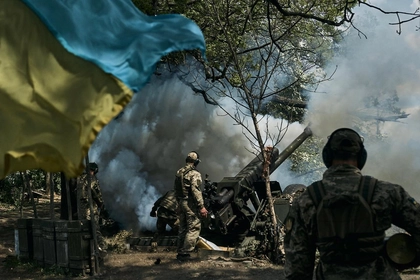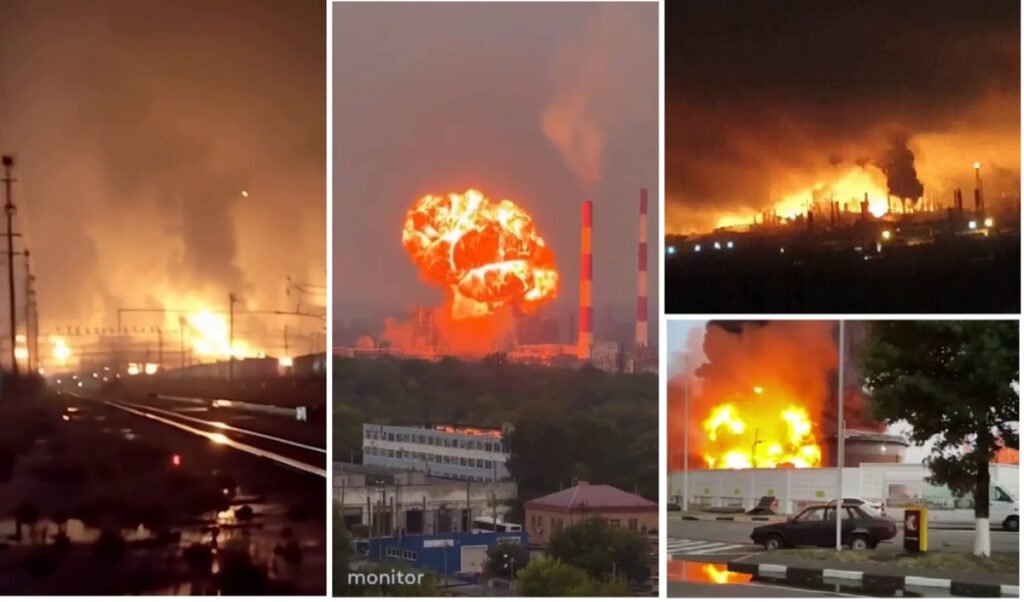Ukraine’s ongoing long-range bombardment of Russia expanded recently to target – and repeatedly torch – oil refineries and trains carrying fuel in the south and west of the country.
The strikes, at times employing dozens of kamikaze drones against individual facilities kicked off in early August. By all accounts these have cut deeply into production capacity, spiking Russian gas pump and wholesale fuel prices.
JOIN US ON TELEGRAM
Follow our coverage of the war on the @Kyivpost_official.
Kyiv’s most recent air raid against Russia’s energy infrastructure came during the early hours of Tuesday, with a reported 10-20 Ukrainian Liuytiy drones breaking through local air defenses to hit a railroad switching yard in the village of Tatsinskaya, in Russia’s south-western Rostov region.
Local social media reported scattered small arms fire as the drones approached, followed by multiple ground explosions. Video showed showed station buildings and a train with fuel cars burning fiercely, with flames reaching at least 20 meters (65 feet) into the sky.
The Tatsinskaya strike came on the heels of an Aug. 2-3 drone raid against an oil production and storage site operated by the major Russian energy corporation Rosneft in the Black Sea resort city of Adler. Over 20 ground explosions were reported, along with images of massive reservoir fires that caused the nearby Sochi International Airport to be temporarily shut down.
On Aug. 1-2 Ukraine launched one of the most ambitious and wide-reaching drone attacks against Russia of the entire war, reportedly pushing more than 100 strike aircraft deep into Russian air space.

Other Topics of Interest
Ukraine’s 10 Biggest Successes of the War
From battlefield victories to symbolic blows, Ukraine has defied expectations and reshaped the war and international attitudes. Here are 10 of its biggest successes according to a Finnish analyst.
One strike package hit the Ryazan Oil Refinery, south-east of Moscow and some 500 kilometers (312 miles) from Ukraine-controlled territory, resulting in a major fire – which local shrugged off as minor damage from a downed drone.
According to Ukrainian sources, the giant Ryazan facility is Russia’s fourth largest refinery and produces about six percent of all of its refined fossil fuel.
The same night Ukrainian kamikaze drones hit the Novokuibyshevsk Oil Refinery, near the city of Samara, some 900 kilometers (560 miles) from the frontline. Multiple ground strikes were reported and local residents recorded mushroom cloud explosions following hits. One civilian died from falling debris, and authorities ordered a shut-down of local mobile internet connections and operations at Samara airport.
A Sunday announcement by Ukraine’s Unmanned Systems Forces identified the elite 14th Separate Unmanned Aircraft Regiment as responsible for Sunday’s strikes. They claimed long-range drones also hit and damaged the Annanefteprodukt fuel storage facility near the Russian city Voronezh the same night.
Battle damage assessments were in progress but hindered by another shut-down of the mobile internet by local authorities, which prevented local civilians from uploading images of the results and inhibited the ability of Ukrainian army intelligence to review the outcome.
Russia’s alternative “assessment”
In contrast to Ukrainian claims and the evidence on social media, RTussian authorities continue to downplay the effects of Ukrainian drone strikes.
On the night of Aug.1-2 the Russian Defense Ministry claimed 112 Ukrainian drones were shot down causing only minor damage from falling debris at “limited” but unspecified locations.
However, Ukrainian news platforms and NASA’s FIRM world fire watch network showed a massive fire on the premises of an oil refinery near the town of Kstovo in Russia’s Nizhegorodskiy region – its Governor said air defenses repelled the attack.
The widely-read Russian business magazine Kommersant in a Monday article reported that industry experts had estimated that Ukrainian strikes over the previous 72 hours had cut Russian fuel production by as much as 40,000 tons a day. AS a result the wholesale price of A-95 gasoline rose to a new high of 77,000 rubles ($932) per metric ton – breaking September 2023’s previous record.
The independent Russian news agency SOTA also reported parallel price spikes for diesel and lower-octane gasoline on Monday, predicting prices were likely to continue to rise because about half of the Ryazan oil refinery capacity was off-line, and the Novokuibyshevsk facility, producing 2-2.5 percent of all of Russia’s refined energy products, was completely shut down.
In a bid to prevent domestic fuel price inflation, the Russian government announced a ban on gasoline exports for most producers to run from July 30 to August 31, which could be extended until the end of September, Kommersant said.
Kommersant also said that repairs to damaged facilities could take as much as six months although previously, following past Ukrainian attacks, production volumes restarted more quickly. Open sources say Ukrainian strikes had hit and damaged the Ryazan facility at least five times prior to the Sunday attack – in March and May 2024, in January (twice) and again in February 2025.
The flurry of Ukrainian strikes against Russian energy production capacity has come against a background of threatened US sanctions against Russian energy buyers China and India, potentially to be put into effect on Aug. 7. In another move that potentially threatens Russia’s worldwide market share, the oil exporting cartel OPEC announced on Monday it would increase production by 547,000 barrels per day, effective from September.
It’s not just energy
Ukrainian bombardment of Russian refineries and fuel car trains has been paralleled by a strike campaign taking on a smorgasbord of targets including arms production facilities, air defense systems, air bases and ammunition storage sites. In late July Kyiv’s top priority based on the number of attacks was railroad infrastructure in south-west Russia.
Along with the Tatsinskaya strike, Tuesday saw at least one Ukrainian drone detonate on the territory of the Stara Stanitsa electric traction substation, a railroad facility in the Rostov region. Local social media reported multiple ground explosions and published images geo-located showing the station’s power transformer ablaze. Acting Rostov region Governor Yuri Slyusar said in a statement that “falling debris” from a shot-down drone caused a fire and reassured voters authorities had brought the fire under control.
The NASA-run FIRMS world satellite watch system showed a major fire burning in the vicinity of the substation. Later on Tuesday, the main electricity utility company for Russia’s Rostov region, Donenergo, announced that a “technical violation of the energy transmission network had caused a partial disconnection of customers.”
During the ambitious Saturday air raids, aside from energy infrastructure, Ukrainian drones knocked out a major air defense radar in Russian-occupied Crimea, hit an airfield warehouse near the town of Primorsko-Akhtarsk, attacked a railroad traction substation and electricity transformers in a town nearby, and drones crashed into two military electronics factories in the city of Penza deep inside Russia.
Probably the most spectacular Ukrainian drone raid in the past week took place overnight on Aug. 3-4, when UAV struck the Saky airbase in Crimea which, according to open sources, destroyed a Russian Air Force Su-30SM fighter jet and damaged another on the ground. The Ukrainian military claimed as many as three Su-24 aircraft at the base had also been damaged or destroyed, along with a stockpile of aviation munitions.
The official Russian statement said the Saky strike caused limited damage and accused Kyiv of intentionally attacking civilian targets.

